
NCERT Solutions For Class 7 Social Science History Chapter 10 Eighteenth-Century Political Formations. We also provide Notes and Lesson Plan. Our Study Rankers specially made them for better understanding. Students may read the NCERT Social Science History Chapter 10 PDF to practice concepts with NCERT Solutions and Extra Questions and Answers. These are prepared by keeping in mind the latest CBSE curriculum. Shine among your friends after scoring high in Quiz, MCQ, and Worksheet.
Read more:NCERT Solutions for Class 7 Social Science History Chapter 7 Tribes, Nomads And Settled Communities
Notes For NCERT Solutions For Class 7 Social Science History Chapter 10 Eighteenth Century Political Formations
(Also find NCERT Solutions For Class 7 Social Science History Chapter 10 Eighteenth-Century Political Formations given below)
- Political conditions in eighteenth-century India changed quite dramatically. It changed within a relatively short span of time.
The Crisis of the Empire and
the Later Mughals
- The Mughal Empire reached the height of its success. But, started facing a variety of crises towards the closing years of the seventeenth century.
- You must have learnt about the Mughal Empire in History Chapter 4
Factors Causing the Termination of Mughals
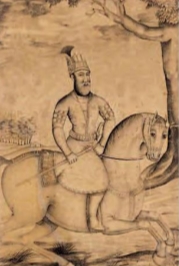
- Emperor Aurangzeb had depleted the military and financial resources of his empire. This was because of fighting a long war in the Deccan.
- The efficiency of the imperial administration broke down.
- It became increasingly difficult for the later Mughal emperors to keep a check on their powerful mansabdars.
- Nobles appointed as governors (subadars) often controlled the offices of revenue. They also controlled military administration (Diwani and faujdari).
- This gave them extraordinary political, economic, and military powers over vast regions of the Mughal Empire.
- Peasant and zamindari rebellions in many parts of northern and western India added to these problems.
- Pressures of mounting taxes caused these revolts.
- At other times they were attempts by powerful chieftains to consolidate their own positions.
- The ruler of Iran, Nadir Shah, sacked and looted the city of Delhi in 1739. He took away immense amounts of wealth.
- Following this, Afghan ruler Ahmad Shah Abdali, invaded north India five times between 1748 and 1761.
- Competition amongst different groups of nobles weakened the empire. They were divided into two major groups – the Iranis and Taranis (nobles of Turkish descent).
- The worst possible humiliation came when two Mughal emperors, Farrukh Siyar (1713-1719) and Alamgir II (1754-1759) were assassinated. Two others Ahmad Shah (1748-1754) and Shah Alam II (1759-1816) were blinded by their nobles.
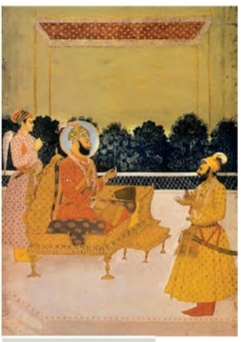
NCERT Social Science History Chapter 10 Fig. 10.2
Hence, the Mughal emperors after Aurangzeb were unable to control the gradual shifting of political and economic authority into the hands of provincial governors, local chieftains, and other groups.
Emergence of New States
- With the decline in the authority of the Mughal emperors, the governors of large provinces, subadars, and the great zamindars consolidated their authority in different parts of the subcontinent.
- Through the eighteenth century, the Mughal Empire gradually broke down into a number of independent, regional states.
Broadly, three overlapping groups divided the states of the eighteenth century. These are:
- States that were old Mughal provinces. Like Awadh, Bengal, and Hyderabad. They were extremely powerful and quite independent. But, the rulers of these states did not break their formal ties with the Mughal emperor.
- States that had enjoyed considerable independence under the Mughals. Like watan jagirs. These included several Rajput principalities.
- The control of Marathas, Sikhs, and others like the Jats. These were of different sizes. They had seized their independence from the Mughals. This was possible after a long-drawn armed struggle.
The Old Mughal Provinces
- The old Mughal provinces in the eighteenth century, carved many states out of which, three stand out very prominently.
- These were Awadh, Bengal, and Hyderabad.
- Members of the high Mughal nobility found all three states.
- They were governors of large provinces – Sa‘adat Khan (Awadh), Murshid Quli Khan (Bengal), and Asaf Jah (Hyderabad).
- All three had occupied high mansabdari positions. They enjoyed the trust and confidence of the emperors.
- Both Asaf Jah and Murshid Quli Khan held a zat rank of 7,000 each.
- Sa’adat Khan’s zat was 6,000.
Hyderabad
- The founder of Hyderabad state was Nizam-ul-Mulk Asaf Jah. He was one of the most powerful members of the court of the Mughal Emperor Farrukh Siyar.
- The governorship of Awadh trusted him. Later, he was given charge of the Deccan.
- As the Mughal governor of the Deccan provinces, Asaf Jah had full control over its political and financial administration.
- He took advantage of the confusion in the Deccan and the competition amongst the court nobility. He gathered power in his hands and became the actual ruler of that region.
- Asaf Jah brought skilled soldiers and administrators from northern India. They welcomed the new opportunities in the south.
- He appointed mansabdars and granted jagirs. Although he was still a servant of the Mughal emperor, he ruled quite independently.
- The Mughal emperor rarely confirmed the decisions taken by the Nizam.
- Hyderabad was constantly engaged in a struggle against the Marathas to the west and with independent Telugu warrior chiefs (nayakas) of the plateau.
- The ambitions of the Nizam to control the rich textile-producing areas of the Coromandel coast in the east were checked by the British. They were becoming increasingly powerful in that region.
Awadh
- Burhan-ul-Mulk Sa‘adat Khan was subadar of Awadh in 1722. He founded a state. This state was one of the most important to emerge out of the break-up of the Mughal Empire.
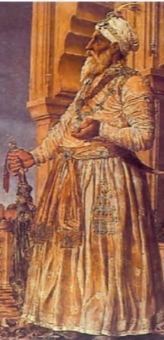
NCERT Social Science History Chapter 10 Fig. 10.3
- Awadh was a prosperous region. It controlled the rich alluvial Ganga plain and the main trade route between North India and Bengal.
- Burhan-ul-Mulk held the combined offices of subadari, diwani, and faujdari.
- He was responsible for managing the political, financial, and military affairs of Awadh.
- Burhan-ul-Mulk tried to decrease Mughal influence in the Awadh region.
- He did this by reducing the number of officeholders (jagirdars) appointed by the Mughals.
- He also reduced the size of jagirs and appointed his own loyal servants to vacant positions.
- The accounts of jagirdars were checked to prevent cheating. The Nawab’s court appointed officials to reassess the revenues of all districts.
- He seized a number of Rajput zamindaris and the agriculturally fertile lands of the Afghans of Rohilkhand.
- The state depended on local bankers and mahajans for loans.
- It sold the right to collect tax to the highest bidders.
- These “revenue farmers” (ijaradars) agreed to pay the state a fixed sum of money.
- Local bankers guaranteed the payment of this contracted amount to the state.
- In turn, the revenue-farmers were given considerable freedom in the assessment and collection of taxes.
- These developments allowed new social groups, like moneylenders and bankers, to influence the management of the state’s revenue system.
Bengal
- Bengal gradually broke away from Mughal control under Murshid Quli Khan. He was appointed as the naib, deputy to the governor of the province.
- He was not a formal subadar. But, he quickly seized all the power that went with that office.
- He also commanded the revenue administration of the state.
- In an effort to reduce the Mughal influence in Bengal, he transferred all Mughal jagirdars to Orissa.
- He also ordered a major reassessment of the revenues of Bengal.
- Revenue was collected in cash with great strictness from all zamindars.
- As a result, many zamindars had to borrow money from bankers and moneylenders.
- Those unable to pay were forced to sell their lands to larger zamindars.
- Therefore, the formation of a regional state in eighteenth-century Bengal led to considerable change amongst the zamindars.
- The close connection between the state and bankers was evident in Bengal under the rule of Alivardi Khan.
- During his reign, the banking house of Jagat Seth became extremely prosperous.
Similarities Among the Old Mughal Provinces
We can detect three common features amongst these states:
- Erstwhile Mughal nobles established many of the larger states. But, they were highly suspicious of their inherited administrative systems. Particularly, the jagirdari system.
- Their method of tax collection differed. They did not rely upon the officers of the state. But, all three regimes contracted with revenue-farmers for the collection of revenue.
- Mughals disapproved of the practice of ijaradari. But, it spread all over India in the eighteenth century.
- Their impact on the countryside differed considerably.
- Their emerging relationship with rich bankers and merchants. These people lent money to revenue farmers. They received land as security and collected taxes from these lands through their own agents. Throughout India, the richest merchants and bankers were gaining a stake in the new political order.
The Watan Jagirs Of the Rajputs
- Many Rajput kings, particularly those belonging to Amber and Jodhpur, had served under the Mughals with distinction.
- In exchange, Mughals permitted them to enjoy considerable autonomy in their watan jagirs.
- In the eighteenth century, these rulers now attempted to extend their control over adjacent regions.
- Ajit Singh, the ruler of Jodhpur, was also involved in the factional politics at the Mughal court.
- These influential Rajput families claimed the subadari of the rich provinces of Gujarat and Malwa.
- Raja Ajit Singh of Jodhpur held the governorship of Gujarat and Sawai. Raja Jai Singh of Amber was governor of Malwa.
- Emperor Jahandar Shah in 1713 renewed these offices.
- They also tried to extend their territories. They tried this by seizing portions of imperial territories neighbouring their watans.
- The house of Jodhpur conquered and occupied Nagaur. Amber seized large portions of Bundi.
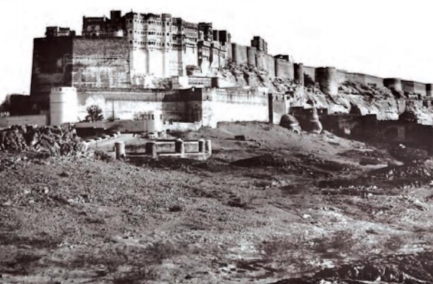
NCERT Social Science History Chapter 10 Fig. 10.5
- Sawai Raja Jai Singh founded the New capital at Jaipur. The subadari of Agra was given to him in 1722.
- Maratha campaigns into Rajasthan from the 1740s put severe pressure on these principalities. They also checked their further expansion.
Seizing Independence
The Sikhs
- The organization of the Sikhs into a political community during the seventeenth century helped in regional state-building in Punjab.
- Guru Gobind Singh fought many battles.
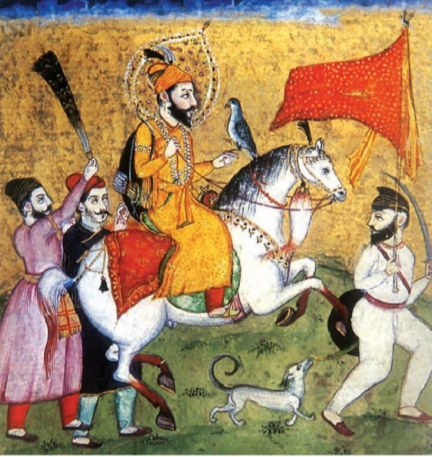
NCERT Social Science History Chapter 10 Fig. 10.6
- He fought against the Rajput and Mughal rulers.
- Guru Gobind Singh fought both before and after the institution of the Khalsa in 1699.
- After his death in 1708, the Khalsa rose in revolt against the Mughal authority under Banda Bahadur’s leadership.
- It declared their sovereign rule by striking coins in the name of Guru Nanak and Guru Gobind Singh.
- They also established their own administration between the Sutlej and the Jamuna.
- Banda Bahadur was captured in 1715. He was executed in 1716.
Dal Khalsa
- Under a number of able leaders in the eighteenth century, the Sikhs organized themselves into a number of bands called jathas. Later on, they became misls.
- The grand army (Dal Khalsa) was their combined forces.
- The entire body used to meet at Amritsar at the time of Baisakhi and Diwali to take collective decisions. These were known as “resolutions of the Guru (gurmatas)”.
- Rakhi, a system offered protection to cultivators on the payment of a tax of 20 percent of the produce.
- Guru Gobind Singh had inspired the Khalsa with the belief that their destiny was to rule (Raj Karega Khalsa).
- Their well-knit organization enabled them to put up a successful resistance first to the Mughal governors. Then to Ahmad Shah Abdali who had seized the rich province of the Punjab and the Sarkar of Sirhind from the Mughals.
- The Khalsa declared their sovereign rule by striking their own coin again in 1765.
- Significantly, this coin bore the same inscription like the one on the orders issued by the Khalsa in the time of Banda Bahadur.
- The Sikh territories in the late eighteenth century extended from the Indus to the Jamuna. But, different rulers divided them.
- Maharaja Ranjit Singh reunited these groups. He established his capital at Lahore in 1799.

NCERT Social Science History Chapter 10 Fig. 10.7
The Marathas
Shivaji
- The Maratha kingdom was another powerful regional kingdom to arise out of sustained opposition to the Mughal rule.
- Shivaji carved out a stable kingdom. He did this with the support of powerful warrior families (deshmukhs).
- Groups of highly mobile, peasant pastoralists (kunbis) provided the backbone of the Maratha army.
- Shivaji used these forces to challenge the Mughals in the peninsula. After Shivaji’s death, power in the Maratha state was wielded by a family of Chitpavan Brahmanas. They served Shivaji’s successors as Peshwa (or principal minister).
Peshwas
- Poona became the capital of the Maratha kingdom.
- Under the Peshwas, the Marathas developed a very successful military organization.
- Their success lay in bypassing the fortified areas of the Mughals. They defeated Mughals by raiding cities and by engaging Mughal armies in special areas. These areas where their supply lines and reinforcements could be easily disturbed.
Expansion Of Maratha Empire
- Between 1720 and 1761, the Maratha empire expanded.
- It gradually weakened the authority of the Mughal Empire.
- Malwa and Gujarat were seized from the Mughals by the 1720s.
- By the 1730s, the overlord of the entire Deccan peninsula was the Maratha king.
- He possessed the right to levy Chauth and sardeshmukhi in the entire region.
- After raiding Delhi in 1737, the frontiers of Maratha domination expanded rapidly into:
- Rajasthan and Punjab in the north
- Bengal and Orissa in the east
- Karnataka and the Tamil and Telugu countries in the south.
- Maratha Empire did not include them formally. But, they made them to pay tribute as a way of accepting Maratha sovereignty.
- Expansion brought enormous resources, but it came at a price.
- These military campaigns also made other rulers hostile towards the Marathas.
- Hence, they did not support the Marathas during the third battle of Panipat in 1761.
Reign Of Marathas
- Alongside endless military campaigns. The Marathas also developed an effective administrative system.
- Once Marathas had conquest and Maratha rule was secure. They introduced revenue demands. They did this by taking local conditions into account.
- Marathas encouraged agriculture. They revived the trade.
- This allowed Maratha chiefs (sardars) like Sindhia of Gwalior, Gaekwad of Baroda, and Bhonsle of Nagpur the resources to raise powerful armies.
Overview of different regions
- Maratha campaigns into Malwa in the 1720s did not challenge the growth and prosperity of the cities in the region.
- Ujjain expanded under Sindhia’s patronage. Indore expanded under Holkar’s.
Trade Routes
- These cities were large and prosperous. They functioned as important commercial and cultural centers.
- New trade routes emerged within the areas controlled by the Marathas.
- The silk was produced in the Chanderi region. It found a new outlet in Poona.
- Burhanpur had earlier participated in the trade between Agra and Surat. It now expanded its hinterland to include Poona and Nagpur in the south. And Lucknow and Allahabad in the east.
The Jats
- The Jats consolidated their power during the late seventeenth and eighteenth-centuries.
- Under their leader, Churaman, they acquired control over territories. These territories were situated to the west of the city of Delhi. By the 1680s they had begun dominating the region between the two imperial cities of Delhi and Agra.
- For a while, they became the virtual custodians of the city of Agra.
- The Jats were prosperous agriculturists.
- Towns like Panipat and Ballabhgarh became important trading centres in the areas dominated by them.
- Under Suraj Mal the kingdom of Bharatpur emerged as a strong state.
- When Nadir Shah sacked Delhi in 1739, many of the city’s notables took refuge there.
- His son Jawahir Shah had 30,000 troops of his own. He hired another 20,000 Maratha and 15,000 Sikh troops to fight the Mughals.
- The Bharatpur fort was built in a fairly traditional style. But, the Jats built an elaborate garden palace combining styles seen at Amber and Agra.
- Its buildings were modelled on architectural forms. These were first associated with royalty under Shah Jahan.
- Learn more about The Jats
The French Revolution
- In the various state systems of eighteenth-century India, the common people did not enjoy the right to participate in the affairs of their governments.
- In the Western world, this was the situation until the late eighteenth century.
- The American (1776-1781) and French Revolutions challenged the social and political privileges enjoyed by the aristocrats.
- During the French Revolution, the middle classes, peasants, and artisans fought against special rights. These rights were enjoyed by the clergy and the nobility.
- They believed that no group in society should have privileges based on birth.
- Rather, people’s social position must depend on merit.
- The philosophers of the French Revolution suggested that there be equal laws and opportunities for all.
- They also held that the authority of the government should come from the people.
- These people must possess the right to participate in its affairs.
- Movements such as the French and American Revolutions gradually transformed subjects into citizens.
- The ideas of citizenship, nation-state, and democratic rights took root in India from the late nineteenth century.
NCERT Solutions For Class 7 Social Science History Chapter 10 Eighteenth Century Political Formations
(Also find NCERT Solutions For Class 7 Social Science History Chapter 10 Eighteenth Century Political Formations given below)
Q. 1. Match the following
| Sabudar | A revenue farmer |
| Faujdar | A high noble |
| Ijaradar | Provincial governor |
| Misl | Maratha peasant warriors |
| Chauth | A Mughal Military Commander |
| Kunbis | A band of Sikh warriors |
| Umara | Tax levied by the Marathas |
A)
| Sabudar | Provincial governor |
| Faujdar | A Mughal Military Commander |
| Ijaradar | A revenue farmer |
| Misl | A band of Sikh warriors |
| Chauth | Tax levied by the Marathas |
| Kunbis | Maratha peasant warriors |
| Umara | A high noble |
Q. 2. Fill in the blanks:
- Aurangzeb fought a protracted war in the …………………
- Umara and jagirdars constituted powerful sections of the Mughal…………….
- Asaf Jah founded the Hyderabad state in ………………….
- The founder of the Awadh state was ………………..
A)
- Aurangzeb fought a protracted war in the Deccan.
- Umara and jagirdars constituted powerful sections of the Mughal administration.
- Asaf Jah founded the Hyderabad state in 1724
- The founder of the Awadh state was Burhan-ul-Mulk Sa’adat Khan.
Q. 3. State whether true or false:
- Nadir Shah invaded Bengal.
- Sawai Raja Jai Singh was the ruler of Indore.
- Guru Gobind Singh was the tenth Guru of the Sikhs.
- Poona became the capital of the Marathas in the eighteenth century.
A)
- Nadir Shah invaded Bengal. FALSE
- Sawai Raja Jai Singh was the ruler of Indore. FALSE
- Guru Gobind Singh was the tenth Guru of the Sikhs. TRUE
- Poona became the capital of the Marathas in the eighteenth century. TRUE
Q. 4. What were the offices held by Sa’adat Khan?
A) Offices held by Sa’adat Khan were:
- Subadari
- Faujdari
- Diwani
He was responsible for managing the political, financial, and military affairs of Awadh.
Q. 5. Why did the Nawab of Awadh and Bengal try to do away with the jagirdari system?
A)
Erstwhile Mughal nobles established many of the larger states. But, they were highly suspicious of their inherited administrative systems. Particularly, the jagirdari system.
- Their method of tax collection differed. They contracted with revenue-farmers for the collection of revenue.
- Mughals disapproved of the practice of ijaradari. But, Nawabs preferred ijaradari over jagirdari system.
- Nawabs lent money to revenue farmers. They received land as security and collected taxes from these lands through their own agents.
Nawabs were aware that if the jagirdari system was not assessed routinely, it will grow it’s authority.
Q. 6. How were the Sikhs organised in the eighteenth century?
A) The organization of the Sikhs into a political community during the seventeenth century helped in regional state-building in Punjab.
- Guru Gobind Singh fought many battles. He fought against the Rajput and Mughal rulers. After his death in 1708, the Khalsa rose in revolt against the Mughal authority under Banda Bahadur’s leadership.
- It declared their sovereign rule by striking coins in the name of Guru Nanak and Guru Gobind Singh. They also established their own administration between the Sutlej and the Jamuna.
- Banda Bahadur was captured in 1715. He was executed in 1716.
- Under a number of able leaders in the eighteenth century, the Sikhs organized themselves into a number of bands called jathas. Later on, they became misls. The grand army (Dal Khalsa) was their combined forces.
- The entire body used to meet at Amritsar at the time of Baisakhi and Diwali to take collective decisions. These were known as “resolutions of the Guru (gurmatas)”.
Their well-knit organization enabled them to put up a successful resistance first to the Mughal governors.
Q. 7. Why did the Marathas want to expand beyond the Deccan?
A)
If Marathas expanded beyond the Deccan, they would enjoy the following privileges:
- Maratha king would become the overlord of the entire Deccan peninsula.
- They would easily weaken the authority of the Mughal Empire.
- They would posses the right to collect Chauth and Sardeshmukhi from the entire region.
Q. 8. What were the policies adopted by Asaf Jah to strengthen his position?
A) The founder of Hyderabad state was Nizam-ul-Mulk Asaf Jah. He was one of the most powerful members of the court of the Mughal Emperor Farrukh Siyar.
- Asaf Jah had full control over its political and financial administration.
- He took advantage of the confusion in the Deccan and the competition amongst the court nobility. He gathered power in his hands and became the actual ruler of that region.
- Asaf Jah brought skilled soldiers and administrators from northern India.
- He appointed mansabdars and granted jagirs.
- He ruled quite independently.
Some Frequently Asked Questions
(Here you can find the NCERT Solutions For Class 7 Social Science History Chapter 10 Eighteenth Century Political Formations FAQs.)
Q. 1. Which group of people challenged Mughal authority for the longest time in Aurangzeb’s reign?
A) The Marathas challenged Mughal authority for the longest time in Aurangzeb’s reign.
Q. 2. In trying to consolidate their rule, why did Mughal subadars also want to control the office of diwan?
A) Mughal subadars also wanted to control the office of diwan because they wanted total control.
Q. 3. What is the Khalsa?
A) Guru Gobind Singh formed the institution of the Khalsa in 1699.
Q. 4. Define Chauth.
A) Chauth is the 25 percent of the land revenue claimed by zamindars. In the Deccan, this was collected by the Marathas.
Q. 5. Define Sardeshmukhi.
A) Sardeshmukhi is the 9-10 percent of the land revenue paid to the head
revenue collector in the Deccan.
Conclusion: NCERT Solutions For Class 7 Social Science History Chapter 10 Eighteenth Century Political Formations
Above written includes NCERT Solutions For Class 7 Social Science History Chapter 10 Eighteenth Century Political Formations, detailed Explanation, and Question Answers. Browse our site for various detailed and easy NCERT Solutions and CBSE Notes.